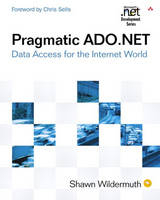
Pragmatic ADO.NET
Addison Wesley (Verlag)
978-0-201-74568-9 (ISBN)
- Titel ist leider vergriffen;
keine Neuauflage - Artikel merken
Developers need a way to interact with all data platforms in a uniform way, and Microsoft has attempted time and again to meet this need with its Universal Data Access strategy. In developing ADO.NET, Microsoft has made their additions of support for XML and disconnected data sets easier to use. This tutorial will guide the reader through ADO.NET from the top down, showing readers the hows and whys of using ADO.NET with lots of examples they can mold into their own projects right away. It is intended to be an introduction to ADO.NET for developers with some knowledge of data access. While it will show readers how ADO.NET follows on its predecessors, it will be written to avoid repeating any remedial instruction in databases and storage theory.
Shawn Wildermuth is the founder of ADOGuy.com and has been building data-driven software for more than sixteen years. Shawn has developed database applications for a variety of fields, including accounting, real estate, Internet, and medicine. His articles can be found in a number of journals, including MSDN Magazine and Windows 2000 Magazine. 0201745682AB10042002
(NOTE: Each chapter concludes with a Conclusion.)
Foreword.
Preface.
Acknowledgments.
I. THE BASICS OF ADO.NET.
1. Why ADO.NET.
A Short History of Universal Data Access.
Why ADO.NET Is a Better Data Access Layer.
A Short Course in ADO.NET.
2. Getting Connected with ADO.NET.
First Impressions.
Connections.
Getting OLE DB Database Schema Information.
Error Handling in .NET.
3. Commanding the Database.
Commands.
Executing Commands.
Database Transactions in ADO.NET.
Batch Queries.
4. Reading Data.
Reading Data.
The DataReader.
Putting It All Together.
II. ALL ABOUT DATASETS.
5. Constructing DataSets.
What is a Dataset.
Filling Datasets.
Defining DataSet Schema.
6. Typed DataSets.
What Are Typed DataSets?
Generating Typed DataSets.
Using Typed DataSets.
Simplification of Business Object Layers.
7. Working with DataSets.
Changing the Data.
Navigating the DataSet.
Searching the DataSet.
Merging DataSets.
8. Updating the Database.
The Trouble with Disconnected Data.
Concurrency in ADO.NET.
Common Updating Issues.
III. ADO.NET IN ACTION.
9. ADO.NET and XML.
.NET and XML.
The DataSet and XML.
The XmlDataDocument Class.
10. Data Binding with ADO.NET.
What is Data Binding in .NET?
Data Binding in Windows Forms.
Data Binding in ASP.NET.
11. Scalability and Performance.
Should You Worry?
Before ADO.NET.
How ADO.NET Can Help.
Are DataReaders Scalable.
ADO.NET Performance.
Best Practices.
Appendix: ADO Migration Strategies
Planning for Migration to ADO.NET.
ADO.NET Equivalents for ADO Objects.
Conclusion.
Index. 0201745682T10112002
| Erscheint lt. Verlag | 14.11.2002 |
|---|---|
| Verlagsort | Boston |
| Sprache | englisch |
| Maße | 187 x 234 mm |
| Gewicht | 750 g |
| Themenwelt | Mathematik / Informatik ► Informatik ► Datenbanken |
| Informatik ► Software Entwicklung ► Objektorientierung | |
| ISBN-10 | 0-201-74568-2 / 0201745682 |
| ISBN-13 | 978-0-201-74568-9 / 9780201745689 |
| Zustand | Neuware |
| Informationen gemäß Produktsicherheitsverordnung (GPSR) | |
| Haben Sie eine Frage zum Produkt? |
aus dem Bereich


